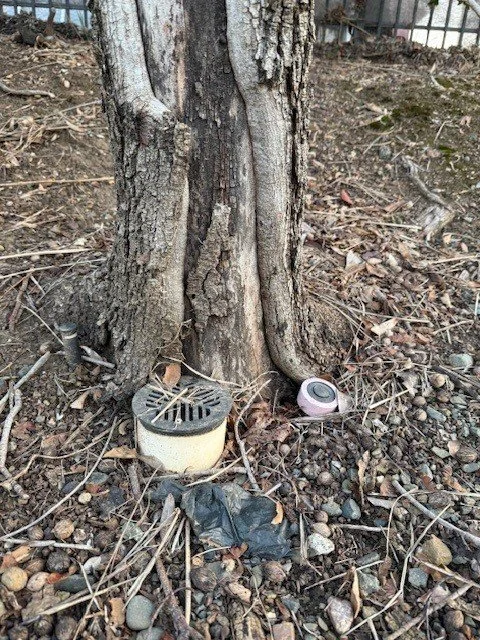How NOT to Plant a Tree: Common Mistakes (and How to Avoid Them)
Planting trees is generally straightforward—dig a hole, place the tree, fill with soil, and water, right? Well, not exactly. If you've ever walked through your neighborhood and seen trees suffering (or failing to thrive), there's a good chance it’s due to poor planting practices. Sadly, even industry "professionals" often miss the mark.
At Align Tree Management, we’ve seen it all—and today we’re shining a light on common planting mistakes, including some misguided industry trends, and showing you how to keep your trees healthy right from the start.
Mistake #1: Using "Air Tubes" (They Don't Work!)
You may have noticed plastic tubes sticking out of the ground at the base of newly planted trees. Known as “air tubes,” these were intended to bring oxygen directly to tree roots. Great theory—except they don’t actually help trees. In fact, they can cause significant damage.
Why Air Tubes Are a Bad Idea:
Trees breathe through soil pores naturally. Tubes don’t add meaningful oxygen flow.
Tubes quickly become clogged, filled with debris, insects, or roots.
Worst of all, as trees grow, their trunks often expand over these tubes, creating severe wounds and exposing inner wood tissue. This damage can permanently weaken the tree and invite decay.
Pro Tip: Skip the tubes. Instead, improve your tree’s soil by using organic mulch and regularly watering deeply to maintain healthy soil structure.
Start with Maintenance
Well maintained trees require less maintenance over time. Starting with an adequate maintenance schedule including removing obsolete equipment is critical to long-term tree health care.
Mistake #2: Misplaced and Neglected Bubblers
Bubbler irrigation can be effective initially, but many people forget one key point: trees grow. Unfortunately, irrigation heads rarely get that memo.
Why Poorly Placed Bubblers Hurt Your Trees:
Bubblers placed right next to trunks can saturate bark, causing decay and disease.
Over time, as tree roots extend, bubblers need to be moved outward from the trunk—yet they often aren't.
Neglected bubblers either underwater critical roots or drown the tree's trunk.
Pro Tip:
Update your irrigation as your tree matures. Move bubblers away from trunks to target the expanding root zone, and regularly check irrigation placement each year. Better yet, consider drip lines or soaker hoses to evenly distribute water.
Mistake #3: Leaving Tree Stakes Up Forever
Perhaps the biggest head-scratcher in our industry is unnecessary staking. While stakes might seem helpful initially, in most cases, they aren’t needed at all. Trees develop stronger root systems and trunks by moving gently in wind, building natural stability and resilience.
Why Long-term Staking is Problematic:
Stakes prevent natural trunk movement, weakening the tree over time.
Ties frequently cause trunk wounds, restricting growth and creating entry points for pests and diseases.
Neglected stakes become eyesores and safety hazards.
Pro Tip:
If staking is absolutely necessary (like in very windy locations), remove stakes after one growing season. A properly planted and cared-for tree rarely needs more than 12 months of staking support.
How to Plant Trees the Right Way
Tree planting doesn't have to be complicated. Stick to these simple, research-backed best practices:
Dig a Proper Hole: Wide but not overly deep—only as deep as the root ball, and at least twice as wide.
Position the Tree Correctly: Ensure the root flare (where trunk transitions into roots) is visible at the soil line, not buried.
Water Deeply & Regularly: Trees establish best with consistent, deep watering that encourages root growth.
Mulch Properly: Apply mulch 2-4 inches deep, away from the trunk, forming a doughnut shape—not a mulch volcano!
Check and Adjust Irrigation Annually: As trees grow, irrigation should evolve accordingly.
Final Thoughts: Time to Change Our Habits
The arboriculture industry—and especially those involved in tree planting—must move beyond outdated practices and embrace evidence-based methods. Trees are living organisms, not static infrastructure. They grow, adapt, and change over time. We, as caretakers, must adapt and change alongside them.
Let’s say goodbye to misguided air tubes, poorly placed bubblers, and permanent stakes. Your trees—and future generations of urban forests—will thank you.
Have a tree planting horror story or question? Drop us a line—we love sharing knowledge and helping trees thrive.
Align Tree Management: promoting smarter tree care practices, one tree at a time!

